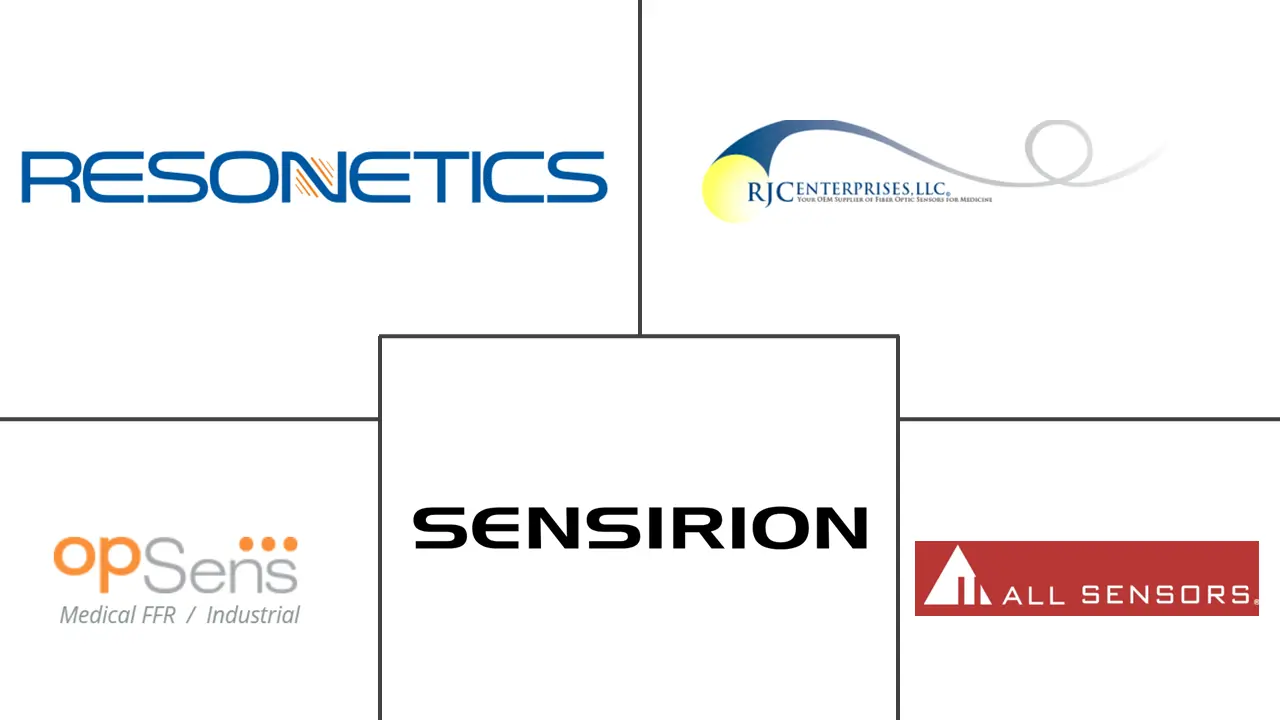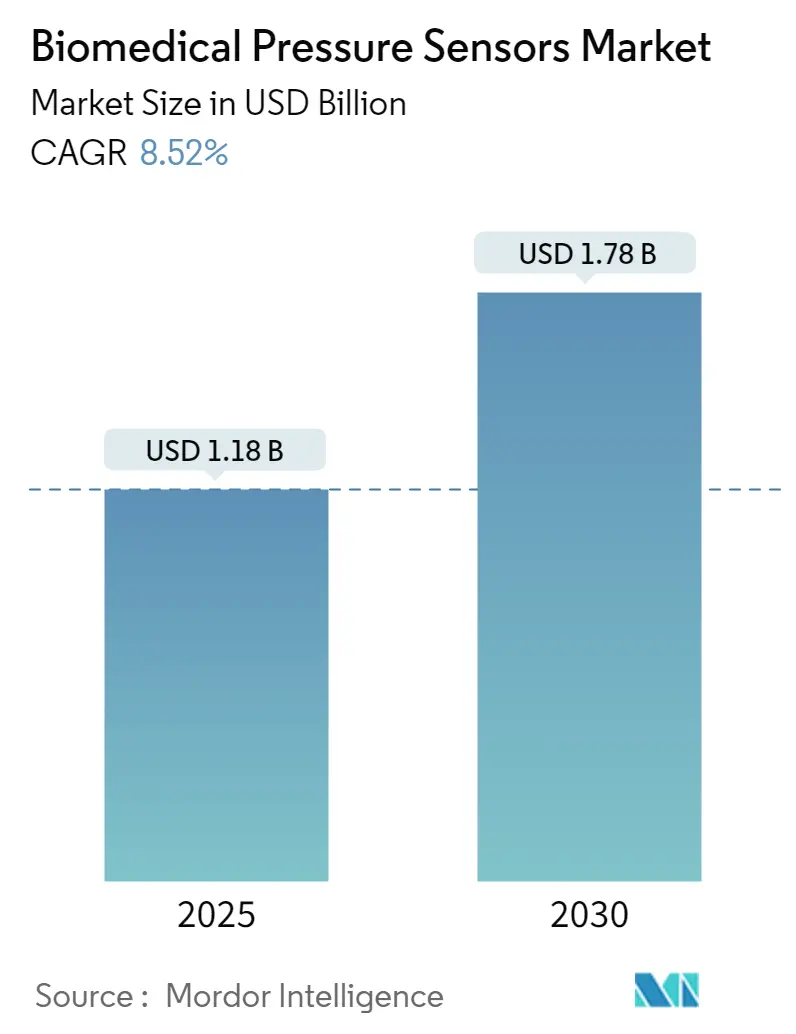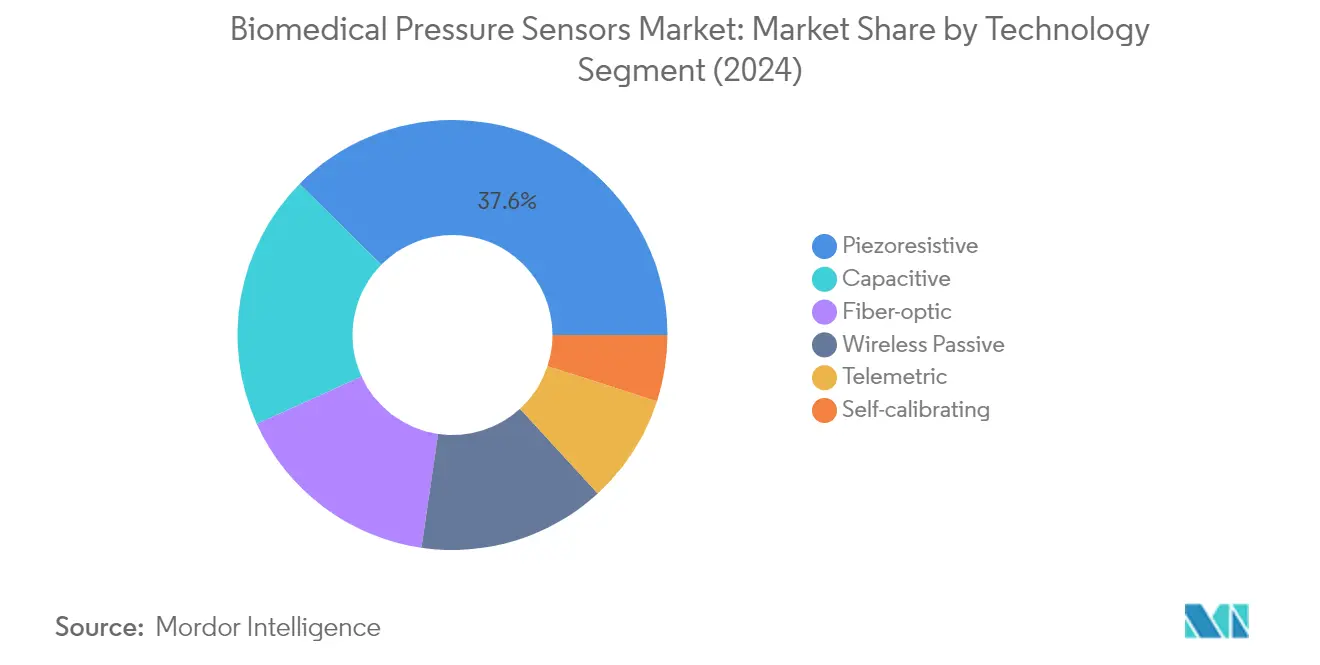Biomedical Pressure Sensors Market Analysis
The Biomedical Pressure Sensors Market size is estimated at USD 1.18 billion in 2025, and is expected to reach USD 1.78 billion by 2030, at a CAGR of 8.52% during the forecast period (2025-2030).
The biomedical pressure sensors industry is experiencing significant transformation driven by broader healthcare spending trends and technological advancement. According to OECD data from 2022, healthcare expenditure as a percentage of GDP reached 16.6% in the United States, followed by Germany at 12.7%, France at 11.9%, and Japan at 11.5%, indicating substantial investment potential in medical technology infrastructure. This increased healthcare spending has catalyzed the development of advanced medical devices incorporating sophisticated medical pressure sensors technologies. The integration of micro-electro-mechanical systems (MEMS) technology has enabled the creation of increasingly miniaturized and precise sensors, fundamentally changing the capabilities of medical devices while improving their portability and effectiveness.
The convergence of biomedical pressure sensors with emerging technologies is reshaping the industry landscape. In August 2023, researchers from the National University of Singapore introduced the innovative aero-elastic pressure sensor 'eAir', demonstrating the industry's focus on enhancing precision in medical applications. The integration of artificial intelligence and Internet of Things (IoT) capabilities with pressure sensors for medical technology has enabled real-time monitoring and data analysis, leading to more accurate diagnostics and treatment protocols. This technological convergence has particularly benefited minimally invasive surgeries, where precise pressure monitoring is crucial for successful outcomes.
The market is witnessing a significant shift toward home healthcare solutions and wearable medical devices. The digital health industry attracted substantial investment, reaching USD 23.3 billion in 2022, reflecting the growing emphasis on remote patient monitoring and personalized healthcare solutions. Superior Sensor Technology's introduction of the VN Series medical pressure sensor family in April 2023 exemplifies the industry's response to the growing demand for home-based medical devices, particularly in respiratory care applications. This trend is driven by the increasing preference for convenient, accessible healthcare solutions that can provide continuous monitoring while reducing the burden on traditional healthcare facilities.
The industry is experiencing rapid advancement in sensor technology applications across various medical fields. According to the National Cancer Institute, cancer survivors in the United States are projected to reach 22.5 million by 2032, representing a 24.4% increase from current levels, driving demand for advanced medical devices incorporating pressure sensors for medical for diagnostic and therapeutic applications. The Indian medtech market's projected growth to USD 50 billion by 2025, at a CAGR of 28%, further illustrates the expanding global market for medical technologies. Manufacturers are focusing on developing customized pressure sensors for medical with enhanced sensitivity, reliability, and compatibility with various medical applications, from diagnostic imaging to patient monitoring systems, while ensuring compliance with stringent medical device regulations.
Biomedical Pressure Sensors Market Trends
Growing Demand for Low-Cost, High-Performance, and Reliable Sensors
The biomedical industry has witnessed remarkable advancements driven by innovations in medical procedures, technologies, and equipment, with biomedical pressure sensors playing a crucial role in providing critical information for these procedures and devices. These sensors, particularly in applications like drug delivery systems, invasive and noninvasive blood pressure measurement, spirometry devices, and intraocular pressure measurements for treating glaucoma, have become essential components in modern healthcare delivery. The growing popularity of portable and personal medical devices has created a strong demand for low-cost yet reliable sensors that help users perform basic healthcare checkups conveniently, reducing the frequency of healthcare facility visits. This trend is particularly evident in the wearables market, where, according to the Consumer Technology Association (CTA), revenue from wearables sales in the United States is anticipated to reach USD 13.8 billion by 2023.
The integration of medical pressure sensors in both hospitals and patient settings has made these devices increasingly accessible in medical facilities, significantly enhancing the patient experience through active participation in personalized healthcare. Recent technological developments have brought forth compact and affordable medical diagnostic instruments to the market, enabling individuals to conveniently monitor their health from home. This advancement has particularly benefited diabetic treatment standards, as new medical diagnostics and tracking systems have proven promising due to their cost-effectiveness and relatively simple production processes. The utilization of compact sensors has gained considerable appeal among healthcare professionals by significantly reducing contamination risks and sterilization expenses associated with medical devices.
Demand for Enhanced Patient Care
The healthcare sector's increasing focus on enhanced patient care has driven significant investments in medical technology and infrastructure globally. According to OECD data from 2022, healthcare expenditure as a percentage of GDP reached notable levels across major economies, with the United States leading at 16.6%, followed by Germany at 12.7%, France at 11.9%, and Japan at 11.5%. This substantial investment in healthcare has created a strong foundation for the adoption of advanced medical technologies, including pressure sensors for medical that offer minimal invasiveness in monitoring biological activities like blood oxygen levels. The demand for bio-sensor technology has seen a particular rise due to various conditions, including sleep apnea, peripheral artery disorders, and pulmonary obstruction.
The integration of pressure sensors for medical has revolutionized post-surgical treatment processes through the implementation of dissolved pressure sensors for brain monitoring and sensors that regulate infection and inflammation in implants. These sensors have proven particularly valuable in therapeutic applications, as evidenced by their use in devices such as nebulizers and chest physiotherapy machines. According to the Global Asthma Report 2022, with asthma affecting 1 in 10 children globally and causing more than 1,000 deaths daily, the demand for accurate and reliable pressure sensors in respiratory therapeutic devices has become crucial. The sensors' ability to measure compressed air flow rates and adjust accordingly ensures precise drug delivery, while in chest physiotherapy machines, they monitor jet pressure for optimal therapeutic effect, demonstrating their vital role in enhancing patient care through improved treatment accuracy and effectiveness.
Segment Analysis: By Technology
Piezoresistive Segment in Biomedical Pressure Sensors Market
The biomedical pressure sensors technology segment maintains its dominant position in the medical pressure sensors market, commanding approximately 38% market share in 2024. This significant market presence is attributed to the segment's versatility and durability in measuring various types of pressure, including absolute, gauge, relative, and differential pressure in both high and low-pressure scenarios. Piezoresistive strain gauges are widely adopted due to their ability to measure pressure by detecting changes in electrical resistance when the material is stretched. These sensors have gained particular prominence in blood pressure monitoring applications, with recent developments focusing on creating highly sensitive and accurate wearable piezoelectric blood pressure sensors for continuous health monitoring. The technology's reliability and cost-effectiveness have made it particularly attractive for medical device manufacturers looking to incorporate pressure-sensing capabilities into their products.
Wireless Passive Segment in Biomedical Pressure Sensors Market
The wireless passive segment is emerging as the fastest-growing technology in the biomedical pressure sensors market, with an expected growth rate of approximately 8% during 2024-2029. This remarkable growth is driven by the increasing adoption of wireless passive LC (inductor-capacitor) pressure sensors in various medical applications, particularly in continuous non-invasive self-monitoring of intraocular pressure. These sensors offer significant advantages as they eliminate the need for power supplies or rigid chips, making them highly suitable for wearable devices. The technology's ability to measure physical signals both internally and externally in the human body, combined with its passive characteristics and simple device structure, has made it particularly valuable for monitoring pressures in sealed or harsh environments. Recent developments in miniaturized LC sensors have expanded their applications to include transcutaneous pressure monitoring, intracranial pressure monitoring, and pressure monitoring of abdominal aortic aneurysms.
Remaining Segments in Biomedical Pressure Sensors Technology
The biomedical fiber optic pressure sensors market encompasses several other significant technology segments, each serving unique applications in the healthcare sector. The capacitive segment offers exceptional precision and consistency across pressure ranges, while fiber-optic technology provides immunity to electromagnetic interference, making it ideal for MRI environments. Telemetric sensors enable wireless transmission of readings from remote locations, particularly valuable in critical care situations. The self-calibrating segment addresses the crucial need for accuracy and reliability in medical applications through automated calibration capabilities. Each of these technologies contributes to the market's diversity by offering specialized solutions for specific medical applications, from diagnostic procedures to patient monitoring and therapeutic devices.
Segment Analysis: By Application
Monitoring Segment in Biomedical Pressure Sensors Market
The monitoring segment dominates the biomedical pressure sensors market, commanding approximately 33% market share in 2024. This significant market position is driven by the extensive use of pressure sensors for medical monitoring applications, including intensive care units, ventilators, ablation machines, and operating rooms. These sensors play a crucial role in monitoring patients' heart rate, respiratory rate, and blood pressure in intensive care settings. In operating rooms, they are essential for monitoring air pressure and fluid levels of surgical instruments. The segment's dominance is further strengthened by the rising adoption of patient monitoring devices in non-hospital settings and the increasing demand for remote monitoring solutions, particularly due to the aging population and prevalence of chronic diseases.
Therapeutic Segment in Biomedical Pressure Sensors Market
The therapeutic segment is emerging as the fastest-growing application area in the medical pressure sensors market, with a projected growth rate of approximately 8% during 2024-2029. This robust growth is primarily driven by the increasing adoption of therapeutic devices such as chest physiotherapy machines and nebulizers that utilize pressure sensors. The segment's growth is further fueled by the rising demand for innovative respiratory drug delivery devices and their increasing adoption among patient populations. The expansion is also supported by the growing prevalence of respiratory diseases such as asthma and chronic obstructive pulmonary disorder (COPD), which necessitate therapeutic interventions using pressure sensor-equipped devices.
Remaining Segments in Biomedical Pressure Sensors Market
The electronic sphygmomanometer pressure sensor market encompasses several other significant segments, including diagnostics, medical imaging, and fitness & wellness applications. The diagnostics segment plays a vital role in various procedures such as arterial blood pressure measurement, pulmonary function testing, and cardiac catheterization labs. The medical imaging segment utilizes pressure sensors in equipment like magnetic resonance imaging (MRI), ultrasound scanners, and computed tomography (CT) scanners for precise image capture and quality control. The fitness and wellness segment is gaining prominence with the increasing adoption of wearable devices and health monitoring systems, while other applications include specialized uses in research and development of biomedical devices and automated drug delivery systems.
Biomedical Pressure Sensors Market Geography Segment Analysis
Biomedical Pressure Sensors Market in North America
North America dominates the global biomedical pressure sensors market, commanding approximately 35% of the total market share in 2024. The region's leadership position is primarily driven by its advanced healthcare infrastructure and high adoption rate of medical pressure sensors. The United States holds a dominant position within North America, characterized by substantial investments in medical device research and development, alongside a growing demand for home healthcare devices. The presence of numerous medical sensor vendors and continuous technological advancements, particularly in nanotechnology and microtechnology applications, further strengthens the region's market position. The market is experiencing significant growth due to the increasing integration of pressure sensors for medical diagnostic equipment, patient monitoring systems, and medical imaging devices. Additionally, the rising focus on connected healthcare solutions and remote patient monitoring capabilities has created new opportunities for biomedical pressure sensor applications. The region's strong emphasis on healthcare innovation, coupled with substantial investments in medical technology advancement, continues to drive market expansion.
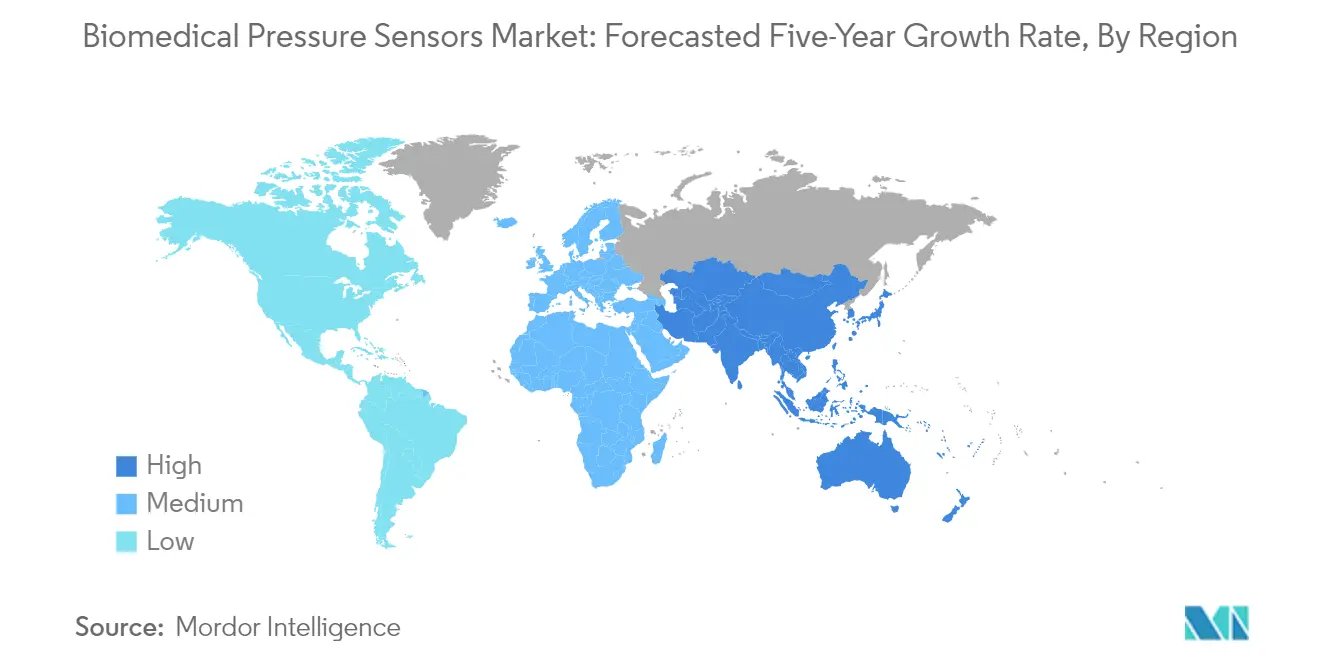
Biomedical Pressure Sensors Market in Europe
Europe represents a significant market for biomedical pressure sensors, demonstrating a robust growth trajectory with approximately an 8% growth rate from 2019 to 2024. The market's expansion is primarily driven by the increasing usage of diagnostic devices and rising demand for monitoring equipment across the healthcare sector. The region's market dynamics are shaped by its strong focus on medical technology innovation and the growing adoption of connected healthcare devices. The presence of well-established healthcare infrastructure, combined with increasing investments in research and development activities, has created a favorable environment for market growth. European countries are witnessing a significant transformation in healthcare delivery models, with an increasing emphasis on home healthcare solutions and remote patient monitoring systems. The region's strong regulatory framework and quality standards have helped maintain high product quality and reliability in the market. Furthermore, the increasing focus on minimally invasive procedures and precision medicine has created additional demand for sophisticated pressure sensing technologies.
Biomedical Pressure Sensors Market in Asia-Pacific
The Asia-Pacific biomedical pressure sensors market is poised for substantial growth, with a projected growth rate of approximately 8% during 2024-2029. The region's market is characterized by rapid industrialization, increasing healthcare expenditure, and growing awareness about advanced medical technologies. Countries like China, Japan, South Korea, and India are emerging as key markets, driven by their expanding healthcare infrastructure and increasing investments in medical device manufacturing. The region's large population base and growing middle class have created substantial demand for advanced healthcare solutions. Local manufacturers are increasingly focusing on developing cost-effective solutions while maintaining quality standards to meet the growing demand. The market is witnessing significant technological advancements, particularly in wearable devices and remote patient monitoring systems. Government initiatives supporting healthcare modernization and the development of medical device manufacturing capabilities are creating favorable conditions for market growth. Additionally, the increasing prevalence of chronic diseases and rising healthcare awareness are driving the adoption of advanced medical devices incorporating pressure sensors.
Biomedical Pressure Sensors Market in Latin America
The Latin American biomedical pressure sensors market is experiencing steady growth, driven by improving healthcare infrastructure and increasing awareness about advanced medical technologies. Brazil, being the largest healthcare market in the region, leads the adoption of advanced medical devices and diagnostic equipment. The region's healthcare sector is undergoing significant transformation, with an increasing focus on modernizing medical facilities and improving patient care quality. The growing prevalence of chronic diseases and rising healthcare expenditure are creating new opportunities for market expansion. Healthcare professionals in the region are increasingly adopting advanced monitoring and diagnostic devices, particularly for managing chronic conditions. The market is also benefiting from increasing investments in healthcare infrastructure and rising adoption of home healthcare solutions. Furthermore, the growing middle-class population and improving access to healthcare services are contributing to market growth. The region's focus on enhancing healthcare delivery systems and increasing adoption of advanced medical technologies continues to drive market development.
Biomedical Pressure Sensors Market in Middle East & Africa
The Middle East & Africa biomedical pressure sensors market is witnessing gradual but steady growth, driven by increasing healthcare investments and a growing focus on healthcare infrastructure development. The Gulf Cooperation Council (GCC) countries, particularly Saudi Arabia and the UAE, are leading the market growth through substantial investments in healthcare modernization. The region is experiencing a significant transformation in its healthcare sector, with increasing emphasis on advanced medical technologies and quality healthcare delivery. The growing prevalence of lifestyle diseases and rising focus on preventive healthcare are creating new opportunities for market expansion. Healthcare facilities in the region are increasingly adopting advanced medical devices and monitoring systems to improve patient care quality. The market is also benefiting from rising private sector participation in healthcare delivery and increasing adoption of digital health solutions. Furthermore, government initiatives supporting healthcare sector development and increasing healthcare awareness are contributing to market growth. The region's focus on developing world-class healthcare infrastructure continues to create favorable conditions for market expansion.
Biomedical Pressure Sensors Industry Overview
Top Companies in Biomedical Pressure Sensors Market
The biomedical pressure sensors market is characterized by companies focusing on continuous innovation and technological advancement in sensor development. Major players are investing significantly in research and development to create more precise, miniaturized, and reliable sensor solutions for medical applications. Companies are emphasizing strategic partnerships and collaborations with medical device manufacturers and healthcare institutions to strengthen their market position. Operational agility is demonstrated through the development of customizable sensor solutions and the ability to adapt to varying customer requirements. Market leaders are expanding their geographic presence through distributor networks and direct sales forces while simultaneously broadening their product portfolios through both internal development and strategic acquisitions. The industry shows a strong trend toward developing sensors with enhanced features such as EMI/RFI immunity, compatibility with various medical devices, and improved accuracy in pressure measurements.
Consolidated Market with Strong Regional Players
The biomedical pressure sensors market exhibits a moderately consolidated structure with a mix of global conglomerates and specialized sensor manufacturers. Global players like Merit Medical Systems, Sensirion Holding AG, and Amphenol Corporation leverage their extensive resources and established distribution networks to maintain market dominance. These companies benefit from their diverse product portfolios and ability to offer comprehensive solutions across multiple medical applications. Regional specialists like Opsens Inc. and RJC Enterprises focus on niche market segments, particularly in fiber optic pressure sensors, where they have developed strong technological expertise and customer relationships.
The market has witnessed strategic mergers and acquisitions as larger companies seek to acquire innovative technologies and expand their product offerings. Companies are increasingly focusing on vertical integration to control quality and reduce dependence on suppliers. The competitive landscape is further shaped by the presence of well-established manufacturing facilities in key regions, allowing companies to maintain close proximity to their customer base and ensure efficient supply chain management. Market players are also investing in building strong relationships with healthcare providers and medical device manufacturers to ensure long-term growth and market stability.
Innovation and Customization Drive Market Success
Success in the biomedical pressure sensors market increasingly depends on companies' ability to innovate and provide customized solutions. Incumbent players must focus on developing next-generation sensor technologies while maintaining strong quality control and regulatory compliance. Companies need to invest in advanced manufacturing capabilities and maintain close relationships with key healthcare providers and medical device manufacturers. Market leaders are expected to continue expanding their product portfolios through both internal development and strategic acquisitions, while also focusing on geographic expansion to capture emerging market opportunities.
For contenders looking to gain market share, specialization in specific applications or technologies offers a viable path forward. New entrants must focus on developing innovative solutions that address unmet needs in the medical sector while building strong partnerships with established medical device manufacturers. The relatively low threat of substitution provides stability for existing players, but regulatory requirements and the need for extensive certifications create significant barriers to entry. Success in this market requires a deep understanding of healthcare regulations, strong quality management systems, and the ability to provide comprehensive technical support to customers throughout the product lifecycle. Companies are also exploring the potential of pressure mapping systems in the healthcare market to enhance patient outcomes and operational efficiency.
Biomedical Pressure Sensors Market Leaders
-
Resonetics LLC
-
RJC Entreprises LLC
-
All Sensors Corporation (Amphenol Corporation)
-
Opsens Inc.
-
Sensirion Holding AG
- *Disclaimer: Major Players sorted in no particular order
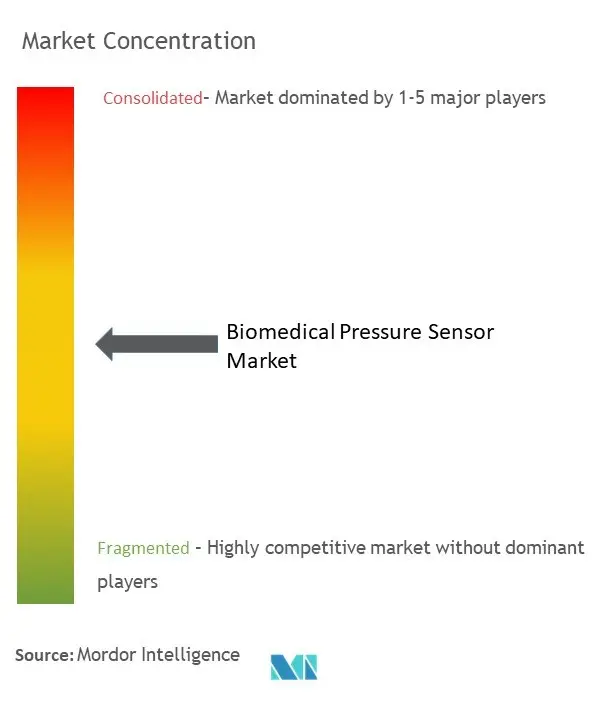
Biomedical Pressure Sensors Market News
- March 2024 - Researchers at Brown University reported notable advancements in wireless sensor technology applicable to biomedical microdevices. This sensor network has been designed to allow chips to be integrated into wearable technology or implanted within the body. The sensors optimize energy consumption and bandwidth by identifying specific events as spikes and utilizing radio waves for real-time wireless data transmission. The researchers believe that this system could serve as a foundation for the future development of wearable and implantable biomedical sensors.
- August 2023 - Researchers at the National University of Singapore (NUS) unveiled eAir, a novel aero-elastic pressure sensor. Drawing from nature's lotus leaf effect, this innovation has been tailored for minimally invasive surgeries and implantable sensors. By overcoming the drawbacks of current pressure sensors, eAir promises heightened precision and reliability in medical settings.
Biomedical Pressure Sensors Market Report - Table of Contents
1. INTRODUCTION
- 1.1 Study Assumptions and Market Definition
- 1.2 Scope of the Study
2. RESEARCH METHODOLOGY
3. EXECUTIVE SUMMARY
4. MARKET INSIGHTS
- 4.1 Market Overview
-
4.2 Industry Attractiveness - Porter's Five Forces Analysis
- 4.2.1 Bargaining Power of Suppliers
- 4.2.2 Bargaining Power of Buyers
- 4.2.3 Threat of New Entrants
- 4.2.4 Threat of Substitutes
- 4.2.5 Degree of Competition
- 4.3 Overview of Pressure Mapping Systems
- 4.4 Impact of Microeconomics Factors on the Market
5. MARKET DYNAMICS
-
5.1 Market Drivers
- 5.1.1 Growing Demand for Low-cost, High-performance, and Reliable Sensors
- 5.1.2 Demand for Enhanced Patient Care
-
5.2 Market Restraints
- 5.2.1 Environmental Impact on Sensors
- 5.2.2 Lack of Product Differentiation
6. MARKET SEGMENTATION
-
6.1 By Technology
- 6.1.1 Self-calibrating
- 6.1.2 Fiber-optic
- 6.1.3 Telemetric
- 6.1.4 Capacitive
- 6.1.5 Wireless Passive
- 6.1.6 Piezoresistive
-
6.2 By Application
- 6.2.1 Diagnostic
- 6.2.2 Therapeutic
- 6.2.3 Medical Imaging
- 6.2.4 Monitoring
- 6.2.5 Fitness and Wellness
- 6.2.6 Other Applications
-
6.3 By Geography
- 6.3.1 North America
- 6.3.2 Europe
- 6.3.3 Asia-Pacific
- 6.3.4 Latin America
- 6.3.5 Middle East and Africa
7. COMPETITIVE LANDSCAPE
-
7.1 Company Profiles
- 7.1.1 Resonetics LLC
- 7.1.2 RJC Entreprises LLC
- 7.1.3 All Sensors Corporation (Amphenol Corporation)
- 7.1.4 Opsens Inc.
- 7.1.5 Sensirion Holding AG
- 7.1.6 Merit Medical Systems Inc.
- *List Not Exhaustive
8. INVESTMENT ANALYSIS
9. FUTURE OF THE MARKET
Biomedical Pressure Sensors Industry Segmentation
Biomedical pressure sensors are used in applications that target three major respiratory disorders: asthma, chronic obstructive pulmonary disease, and sleep apnea. They are used in diagnostic equipment to measure the pressure of air expelled from the lungs and therapeutic equipment, such as oxygen therapy equipment, nebulizers, and ventilators.
The biomedical pressure sensors market is segmented by technology, application, and geography. By technology, the market is segmented into self-calibrating, fiber-optic, telemetric, capacitive, wireless passive, and piezoresistive. By application, the market is divided into diagnostic, therapeutic, medical imaging, monitoring, fitness and wellness, and other applications. By geography, the market is segmented into North America, Europe, Asia-Pacific, Latin America, and Middle East and Africa. The market sizing and forecasts are provided in terms of value (USD) for all the above segments.
| By Technology | Self-calibrating |
| Fiber-optic | |
| Telemetric | |
| Capacitive | |
| Wireless Passive | |
| Piezoresistive | |
| By Application | Diagnostic |
| Therapeutic | |
| Medical Imaging | |
| Monitoring | |
| Fitness and Wellness | |
| Other Applications | |
| By Geography | North America |
| Europe | |
| Asia-Pacific | |
| Latin America | |
| Middle East and Africa |
Biomedical Pressure Sensors Market Research FAQs
How big is the Biomedical Pressure Sensors Market?
The Biomedical Pressure Sensors Market size is expected to reach USD 1.18 billion in 2025 and grow at a CAGR of 8.52% to reach USD 1.78 billion by 2030.
What is the current Biomedical Pressure Sensors Market size?
In 2025, the Biomedical Pressure Sensors Market size is expected to reach USD 1.18 billion.
Who are the key players in Biomedical Pressure Sensors Market?
Resonetics LLC, RJC Entreprises LLC, All Sensors Corporation (Amphenol Corporation), Opsens Inc. and Sensirion Holding AG are the major companies operating in the Biomedical Pressure Sensors Market.
Which is the fastest growing region in Biomedical Pressure Sensors Market?
Asia Pacific is estimated to grow at the highest CAGR over the forecast period (2025-2030).
Which region has the biggest share in Biomedical Pressure Sensors Market?
In 2025, the North America accounts for the largest market share in Biomedical Pressure Sensors Market.
What years does this Biomedical Pressure Sensors Market cover, and what was the market size in 2024?
In 2024, the Biomedical Pressure Sensors Market size was estimated at USD 1.08 billion. The report covers the Biomedical Pressure Sensors Market historical market size for years: 2019, 2020, 2021, 2022, 2023 and 2024. The report also forecasts the Biomedical Pressure Sensors Market size for years: 2025, 2026, 2027, 2028, 2029 and 2030.
Our Best Selling Reports
Biomedical Pressure Sensors Market Research
Mordor Intelligence provides a comprehensive analysis of the biomedical pressure sensors market, utilizing our extensive expertise in the medical device industry. Our detailed examination covers a wide range of medical pressure sensors and their applications. This includes blood pressure transducers and medical flow sensors. The report, available as an easy-to-download PDF, offers an in-depth analysis of pressure sensors for medical applications. It encompasses both flexible pressure sensors and elastic sensors technologies.
The report offers valuable insights for stakeholders across the value chain, from medical pressure sensor manufacturers to healthcare facilities. Our analysis examines various applications such as pressure mapping systems in healthcare and pressure sensors in electronic sphygmomanometers. The research thoroughly evaluates customized pressure sensors for medical applications, providing comprehensive data on technological advancements, regulatory frameworks, and emerging opportunities. Industry participants, including pressure sensors for medical suppliers, can leverage our detailed analysis to make informed strategic decisions and better understand market dynamics.

